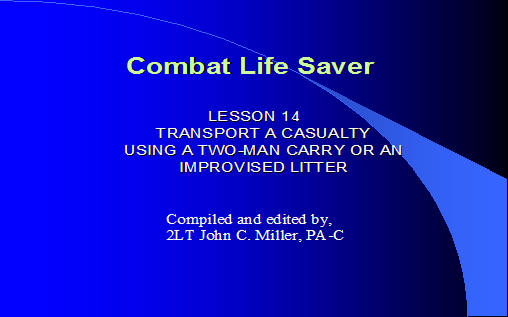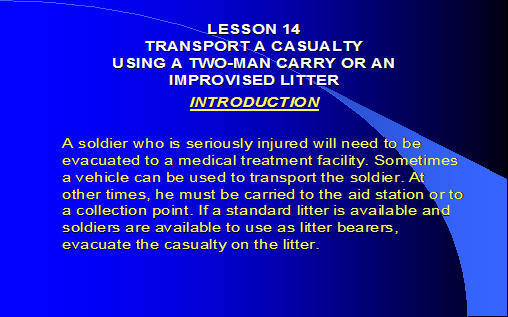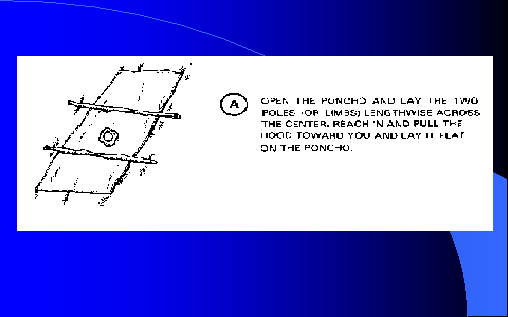Transport a Casualty using a two-man carry or an improvised litter
Click here to download the presentation.



LESSON 14
TRANSPORT A CASUALTY
USING A TWO-MAN CARRY OR AN
IMPROVISED LITTER
INTRODUCTION
A soldier who is seriously injured will need to be evacuated to a medical treatment facility. Sometimes a vehicle can be used to transport the soldier. At other times, he must be carried to the aid station or to a collection point. If a standard litter is available and soldiers are available to use as litter bearers, evacuate the casualty on the litter.
TRANSPORT A CASUALTY
USING A TWO-MAN CARRY OR AN
IMPROVISED LITTER
INTRODUCTION
If a standard litter is not available but materials are available to make an improvised litter and soldiers are available to use as litter bearers, construct an improvised litter and evacuate the casualty on the litter. If litters or time is not available, evacuate the casualty using a two-man manual carry. If only one person can be spared to evacuate the casualty, use a one-man manual carry to transport the casualty.
TRANSPORT A CASUALTY
USING A TWO-MAN CARRY OR AN
IMPROVISED LITTER
TASK
Construct and use an improvised litter.
CONDITIONS
Given materials for constructing an improvised litter and an assistant.
STANDARD
Score a GO on the performance checklist.
TRANSPORT A CASUALTY
USING A TWO-MAN CARRY OR AN
IMPROVISED LITTER
TASK
Transport a casualty using an appropriate two-man carry.
CONDITIONS
Given a simulated casualty and an assistant.
STANDARD
Score a GO on the performance checklist.
CHOOSE THE APPROPRIATE METHOD TO
MOVE A CASUALTY ON THE BATTLEFIELD
The following methods of transporting a casualty are given in the order of preference.
Preferred method: Military vehicle, preferably an air or ground ambulance (discussed in more detail in IS0825).
Second method: Litter, preferably a standard litter if litter and two or more litter bearers are available; otherwise, an improvised litter if materials, time, and bearer(s) are available.
CHOOSE THE APPROPRIATE METHOD TO
MOVE A CASUALTY ON THE BATTLEFIELD
Third method: Manual carry, preferably a two-man carry if an assistant is available; otherwise, a one-man carry.
Do not transport a casualty with a suspected fracture of the neck or back unless it is necessary to save his life. Use a back board if available. Wait until medical personnel arrive, if possible.
MAKE AN IMPROVISED
POLE AND PONCHO LITTER
Obtain two tent poles (or straight tree limbs) and a poncho.
Open the poncho and lay it flat on the ground.
Lay two poles lengthwise across the poncho so the poncho is divided into thirds.
Reach in and pull the hood toward you and lay it flat on the poncho. Make sure the drawstrings are not hanging out of the hole.
Fold one outer third of the poncho over the pole.
Fold the other outer third of the poncho over its pole.
The weight of the casualty will keep the litter from coming apart.
MAKE AN IMPROVISED
POLE AND JACKET LITTER
Obtain two tent poles (or straight tree limbs) and two or three field jackets (or heavy shirts).
Close (zip or button) the garments.
Turn the garments inside out, but leave the sleeves inside. (Having buttons and zippers inside keep them from catching on bushes.)
Pass the poles through the sleeves.
MAKE AN IMPROVISED
POLE AND SACK LITTER
Obtain two tent poles (or straight tree limbs) and two empty, heavy-fabric sacks such as potato sacks.
Cut holes in the two corners of the closed end of each sack.
Place the sacks lengthwise with the open end of the sacks facing each other.
Slide the poles or limbs through the holes.
Overlap the open ends of the sacks about three
inches to provide extra strength in the middle of the litter.
MAKE AN IMPROVISED BLANKET LITTER
Lay a blanket on the ground.
Roll two opposite edges of the blanket toward the middle. The rolled edges of the blanket will serve as grips.
EVACUATE A CASUALTY BY LITTER
A casualty is usually placed on a litter using the modified two-man arms carry or modified two-man fore-and-aft carry.
Normally, four soldiers are used to transport the litter. The litter team, however, can be composed of more or fewer members based upon the military situation and the distance and terrain to be covered.
EVACUATE A CASUALTY BY LITTER
General Rules
Tell the casualty what you are going to do in order to calm his fears and get his cooperation.
Walk around the casualty rather than stepping over him.
Make sure needed treatment procedures (tourniquets, splints, etc.) have already been performed before transporting the casualty unless immediate transportation is needed to save the casualty’s life.
EVACUATE A CASUALTY BY LITTER
General Rules (cont)
Have one person give instructions so actions will be performed in unison.
Avoid causing additional injury to the casualty when placing him on the litter and moving the casualty.
EVACUATE A CASUALTY BY LITTER
Position Casualty and Litter
Position the casualty on his back with his arms at his side. Place the litter (standard or improvised) near and parallel to the casualty.
EVACUATE A CASUALTY BY LITTER
Place Casualty Onto Litter Using the Modified Two-Man Arms Carry
Two litter bearers kneel on one knee by the casualty’s side (opposite side from litter).
One bearer slips his arms under the casualty’s back and waist.
The other bearer slips his hands under the casualty’s hips and knees.
Both bearers lift in unison upon command from the leader.
EVACUATE A CASUALTY BY LITTER
Two-Man Arms Carry (cont)
Bearers move the casualty over the litter or have another soldier push the litter under the casualty.
Bearers lower the casualty onto the litter in unison upon the leader’s command.
EVACUATE A CASUALTY BY LITTER
Place Casualty Onto Litter Using the Modified Two-Man Fore-and-Aft Carry
One bearer kneels behind the casualty’s head and slips his arms under the casualty’s arms and across his chest; then locks his hands together.
The other bearer spreads the casualty’s legs apart and squats or kneels between the casualty’s legs while facing the first bearer.
EVACUATE A CASUALTY BY LITTER
Two-Man Fore-and-Aft Carry (cont)
Both bearers rise in unison upon the leader’s command.
Bearers move the casualty over the litter.
Bearers lower the casualty onto the litter in unison upon the leader’s command.
EVACUATE A CASUALTY BY LITTER
Lift Litter Using a Four-Man Litter Carry
The leader of the litter team positions himself at the handle nearest the casualty’s right shoulder and directs the other bearers.
Each of the three other litter bearers positions himself at one of the handles, faces the same direction as the leader (casualty is usually carried feet first), and kneels on the knee nearest the litter.
Upon command, the litter bearers stand up, lifting the litter in unison, and move the casualty to the aid station or collection point.
MOVE A CASUALTY USING THE TWO-MAN
FORE-AND-AFT CARRY
The two-man fore-and-aft carry is used to transport a conscious or unconscious casualty and is the preferred two-man carry for moving a casualty for a long distance.
Position the casualty on his back with his arms by his side.
The taller of the two bearers kneels at the casualty’s head and faces toward the casualty’s feet, slides his hands under the casualty’s arms and across the casualty’s chest, and locks his hands together over the casualty’s chest.
MOVE A CASUALTY USING THE TWO-MAN
FORE-AND-AFT CARRY
The second bearer spreads the casualty’s legs, kneels between the casualty’s legs with his back to the other bearer, and grasps under the casualty’s knees.
Both bearers rise together, lifting the casualty.
Both bearers walk forward with the casualty.
MOVE A CASUALTY USING THE TWO-MAN
SUPPORT CARRY
This two-man support carry is used to transport a conscious or unconscious casualty, but is especially useful if the casualty is conscious since he may be able to walk or hop with assistance.
Bearers kneel on each side of the casualty and face the same direction as the casualty.
Each bearer takes the casualty’s arm nearest the bearer, brings it around his neck, and grasps the casualty’s wrist with his outside hand.
MOVE A CASUALTY USING THE TWO-MAN
SUPPORT CARRY
Each bearer puts his other arm around the casualty’s waist.
Both bearers rise in unison, lifting the casualty.
If the casualty is unconscious, the bearers should not release the casualty’s wrists.
If the casualty is taller than the bearers, the bearers can remove their arms from the casualty’s waist and use them to lift and support the casualty’s thighs. This keeps the feet from dragging.
Bearers walk forward with the casualty.
MOVE A CASUALTY USING THE TWO-MAN
ARMS CARRY
The two-man arms carry can be used to move a conscious or unconscious casualty for a moderate distance.
More than two bearers may be required if the casualty is heavy or if the casualty’s head or legs need additional support.
Position the casualty on his back and place his hands on his abdomen.
Both bearers position themselves on the same side of the casualty–one at the casualty’s chest and one at his thighs.
MOVE A CASUALTY USING THE TWO-MAN
ARMS CARRY
Both bearers kneel on one knee.
The bearer at the casualty’s chest slips one arm beneath the casualty’s shoulders and the other arm beneath his waist.
The bearer at the casualty’s thighs slips one arm beneath the casualty’s hips and the other arm beneath his knees.
Both bearers shift their weight backward in unison and lift the casualty to knee level, keeping the casualty as level as possible.
MOVE A CASUALTY USING THE TWO-MAN
ARMS CARRY
Both bearers bring the casualty’s front close to their chests.
Both bearers rise to their feet in unison.
Both bearers move forward, carrying the casualty high on their chest to lessen fatigue.
MOVE A CASUALTY USING THE TWO-HAND
SEAT CARRY
The two-hand seat carry can be used to move a conscious or unconscious casualty for a short distance.
Position the casualty on his back.
Bearers position themselves on opposite sides of the casualty’s hips and kneel.
Each bearer passes one arm under the casualty’s back and the other arm under the casualty’s thigh.
The bearers grasp each other’s wrists securely.
Both bearers rise in unison, lifting the casualty.
Both bearers move forward, carrying the casualty.
MOVE A CASUALTY USING THE FOUR-HAND
SEAT CARRY
The four-hand seat carry is used to carry a conscious casualty who can help support himself while he is being carried. This carry is especially useful in transporting a person with a head or foot injury for a moderate distance.
Both bearers position themselves behind the casualty.
Bearers face each other. Each bearer grasps his own left wrist with his right hand and grasps the other bearer’s right wrist with his left hand. The bearer’s forearms form the seat for the casualty.
MOVE A CASUALTY USING THE FOUR-HAND
SEAT CARRY
The casualty stands on his own or another soldier helps the casualty to a standing position.
Both bearers lower their bodies so the seat is about even with the casualty’s knees.
The casualty sits on the bearers’ forearms and places his arms around the bearers’ shoulders for balance and support.
Both bearers stand erect in unison, lifting the casualty.
Both bearers move forward.
TRANSPORT A CASUALTY
USING A TWO-MAN CARRY OR AN
IMPROVISED LITTER
CLOSING
Helping to evacuate casualties from the battlefield is one of the functions of the combat lifesaver. You will probably be the most knowledgeable person in the litter squad and must be prepared to act as the leader of the squad.
Questions